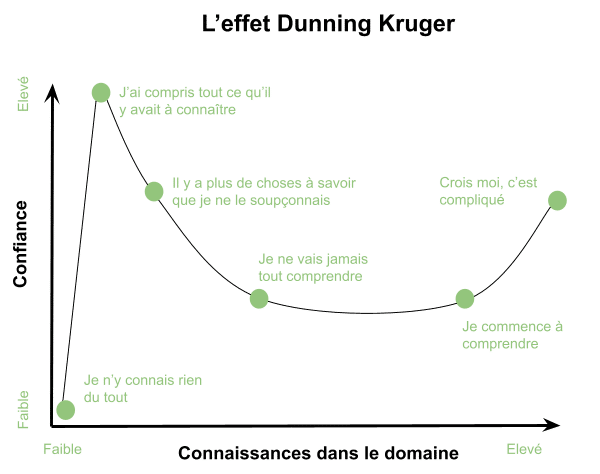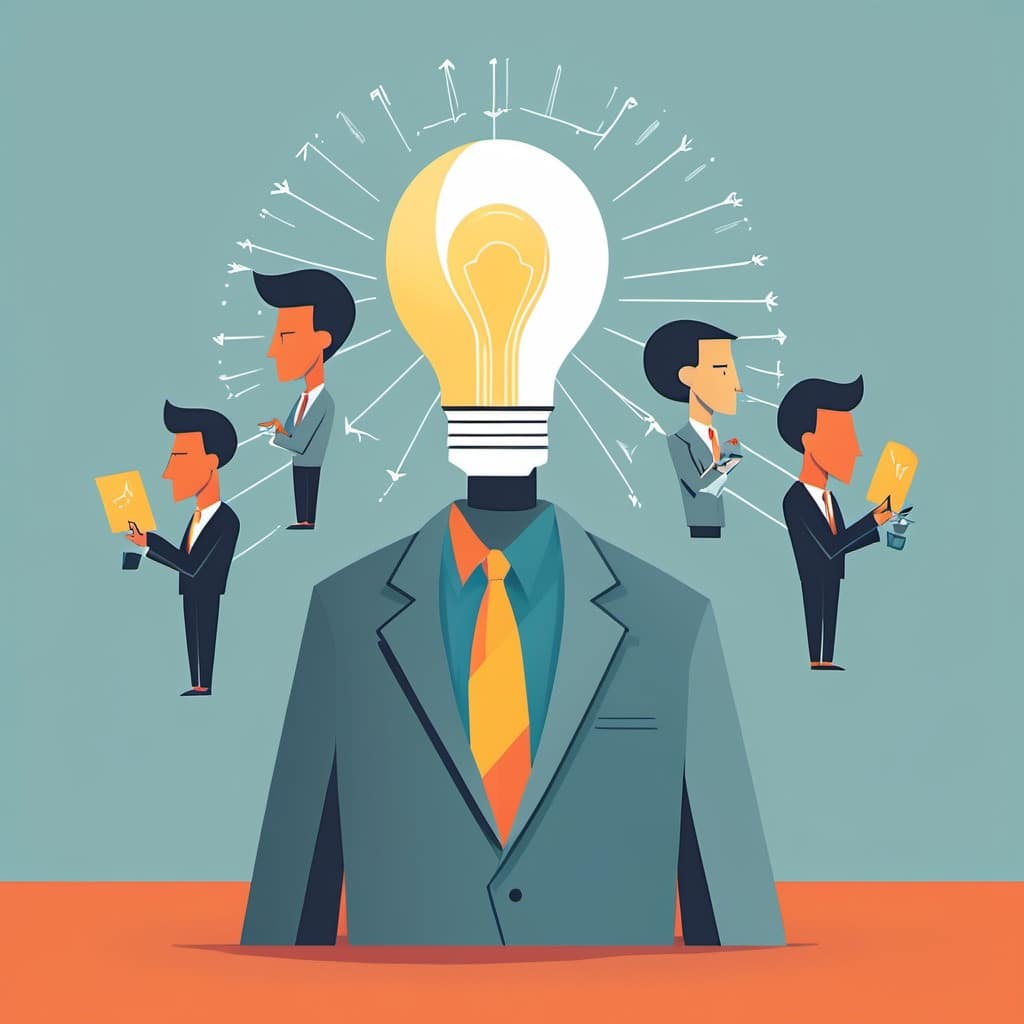In massage therapy, as in any discipline requiring technical know-how and an in-depth understanding of the human body, learning is a gradual process. Sometimes, trainees or practitioners in training overestimate their skills, convinced that they have mastered complex techniques when in fact they have only a superficial knowledge of them. This psychological phenomenon has a name: the Dunning-Kruger effect. Understanding this cognitive bias enables us to adopt a more humble and effective learning posture, while fostering an environment conducive to the development of future massage therapists.
| Contents: What is the Dunning-Kruger effect? The Dunning-Kruger effect curve The brain mechanisms involved How to limit the Dunning-Kruger effect in massage therapy Conclusion |
What is the Dunning-Kruger effect?
The Dunning-Kruger effect is a cognitive bias identified in 1999 by psychologists David Dunning and Justin Kruger. It describes a counter-intuitive phenomenon: people who are the least competent in a field tend to overestimate their abilities, while those who really master a subject tend to underestimate their level of competence.
The concept was born of a surprising incident: a man robbed banks in broad daylight, convinced that he was invisible to surveillance cameras after smearing lemon juice on his face. His reasoning? Since lemon juice is used as an invisible ink, he thought that applying it to his skin would make him undetectable. Intrigued by this display of overconfidence, Dunning and Kruger conducted a series of experiments to understand why some people overestimate their skills despite evidence to the contrary.
By analyzing the results of tests on various skills (logical reasoning, grammar, humor), they observed that the individuals with the lowest scores were also those who most misjudged their performance. Conversely, the most competent individuals tended to underestimate themselves, believing that what was obvious to them was also obvious to others. This asymmetry in self-assessment of competence is based on a paradox highlighted by Charles Darwin: “Ignorance more frequently engenders self-confidence than does knowledge.”
The Dunning-Kruger effect curve
The researchers have illustrated this bias through a learning curve that breaks down into several stages:
- The peak of the “mountain of stupidity”: at this stage, the beginner, having acquired a few notions, is over-confident in his abilities. He ignores everything he doesn’t yet know.
- The “valley of humility”: as he progresses, he becomes aware of how much he still has to learn, which can lead to a lack of confidence.
- The “consolidation plateau”: with experience and continuous learning, confidence stabilizes and becomes proportional to the actual level of competence.

This model illustrates why some people overestimate their knowledge, while others with more experience may doubt their abilities (impostor syndrome).
The brain mechanisms involved
The Dunning-Kruger effect is based on cognitive mechanisms deeply rooted in the functioning of the human brain. In particular, it is associated with deficits in metacognition, i.e. the ability to objectively evaluate one’s own knowledge and performance. This ability is largely dependent on the dorsolateral prefrontal cortex, a region involved in planning, self-reflection and behavioral regulation. Neuroimaging studies have shown that people who are less competent in a domain activate these structures less when evaluating their own performance, which prevents them from detecting their errors and doubting their abilities. In the absence of such self-questioning, the brain reinforces erroneous beliefs through confirmation mechanisms (confirmation bias), where only information that supports overestimation is retained. This phenomenon highlights a cognitive paradox: limited expertise is accompanied by a lack of the cognitive resources needed to perceive the same incompetence. Conversely, the acquisition of knowledge favours a better perception of the limits of one’s knowledge, explaining why experts, although more competent, often tend to underestimate their own mastery of a subject.
How to limit the Dunning-Kruger effect in massage therapy?
Fortunately, this bias is not irreversible, and by becoming aware of its effects it is quite possible to limit its impact on your practice:
- Encourage regular self-assessment: identifying your own strengths and areas for improvement can help you become aware of your shortcomings.
- Encourage constructive feedback: don’t hesitate to ask your trainers, colleagues and customers for specific feedback, encouraging them to be objective and benevolent so that you can assess your skills.
- Rely on supervised practice: during your training, you can ask to be given concrete situations in the presence of qualified people, so as to obtain corrections and adjustments in real time. This will enable you to assess your real level.
- Exposure to complex cases: faced with a variety of real-life situations (musculoskeletal disorders, specific customer needs), you’ll understand the importance of in-depth training, and be able to direct your future training in these precise areas.
- Continuous learning: Massage therapy evolves, techniques are perfected and training never stops: this encourages humility and curiosity.
Conclusion
The Dunning-Kruger effect reminds us that in massage therapy training, as in any field of expertise, our perception of our abilities evolves as we learn. An initial over-confidence can hinder progress, while an awareness of shortcomings opens the way to regular improvement. As practitioners, it is essential to encourage a posture of humility and continuous learning to ensure healthy and effective evolution. The aim is not to curb confidence, but to make it fair and aligned with the reality of the skills acquired.
To remember:
- The Dunning-Kruger effect shows that less competent people tend to overestimate their abilities, while experts may underestimate their level.
- This bias is based on a deficit in metacognition, preventing an objective assessment of one’s own skills. This is observed at the cerebral level in areas responsible for planning, self-reflection and behavioral regulation.
- Continuous learning, questioning and objective feedback are essential to limit the Dunning-Kruger effect and make effective progress.
- A posture of humility and openness fosters balanced, realistic professional development in massage therapy, as in any technical field.
Sources :
- Kruger, J., & Dunning, D. (1999). Unskilled and unaware of it: How difficulties in recognizing one’s own incompetence lead to inflated self-assessments. Journal Of Personality And Social Psychology, 77(6), 1121-1134. https://doi.org/10.1037/0022-3514.77.6.1121
- Mazor, M., & Fleming, S. M. (2021). The Dunning-Kruger effect revisited. Nature human behaviour, 5(6), 677-678. https://doi.org/10.1038/s41562-021-01101-z
- Muller, A., Sirianni, L. A., & Addante, R. J. (2021). Neural correlates of the Dunning-Kruger effect. The European journal of neuroscience, 53(2), 460-484. https://doi.org/10.1111/ejn.14935
- Pennycook, G., Ross, R. M., Koehler, D. J., & Fugelsang, J. A. (2017). Dunning-Kruger effects in reasoning: Theoretical implications of the failure to recognize incompetence. Psychonomic Bulletin & Review, 24(6), 1774-1784. https://doi.org/10.3758/s13423-017-1242-7

